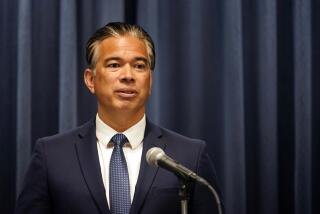Inspection Firm Accused of Being Smoke Screen for Tobacco Industry : Health: Former employee’s suit says Healthy Buildings International sought to deflect concern over secondhand smoke.
- Share via
A novel whistle-blower lawsuit says a consulting firm that inspected federal buildings for indoor pollution actually was a front for tobacco companies that used it to deflect concern about secondhand smoke.
The suit, filed in federal court in Washington, alleges that Healthy Buildings International Inc. defrauded federal agencies by failing to disclose that it “was directly and secretly subsidized” by tobacco companies “to promote the tobacco industry’s position on smoking in return for payment of monies.”
The plaintiff, former company employee Jeffrey R. Seckler, seeks damages triple the amount the firm received for government building inspections from 1989 to 1992. Under the federal False Claims Act, he would get up to 25% of any damages awarded the government.
Seckler filed the suit in April. As is customary in such cases, it remained under seal for months, until Justice Department lawyers decided they would not join in the case. It was made public by the U.S. District Court in Washington this week.
Whistle-blower claims more commonly allege fraud in big defense contracts. Although not estimated in the suit, the dollar value of Healthy Buildings’ government contracts--with agencies including the Department of Health and Human Services and the General Services Administration--is believed to be small.
But the suit contains the unusual claim that tobacco firms spent millions of dollars to make a small consulting firm a giant in its field in order to use it in their global war against smoking bans.
Gray Robertson, president of Fairfax, Va.-based Healthy Buildings, and tobacco industry spokespersons all declined to comment, saying they had not yet seen the lawsuit. Robertson previously has said he never altered his views to suit the cigarette makers.
Seckler also declined to comment, on the advice of his attorney. He has said he hoped to make up for his own involvement by exposing the firm’s activities.
Proclaimed “the building doctor” by such media as People magazine, Robertson became a much-quoted authority on “sick building syndrome,” in which dust, gases and bacteria in weather-tight buildings make the occupants sick.
In scores of media interviews and legislative hearings, Robertson and other Healthy Buildings executives attributed foul indoor air to poor ventilation and filtration systems that failed to dissipate a host of invisible poisons. They said tobacco smoke was an overrated problem--that, as the most noticeable contaminant, it was “a canary in a coal mine,” a useful marker of poor ventilation.
The firm’s extensive ties to the cigarette makers were first disclosed by The Times in February, 1992, following a press briefing by Robertson in Universal City. An internal Tobacco Institute memo had described him as one “of the consultants and allies we use to refer reporters to. . . . (H)e’s terrific and the press loves him.”
The suit alleges that Healthy Buildings received a variety of fees and subsidies from the Tobacco Institute, Philip Morris and R.J. Reynolds, including large monthly retainers, public relations support and payment of employee salaries.
The suit says Philip Morris underwrote and controlled the content of a glossy house organ, Healthy Buildings International magazine, which was translated into several languages and distributed worldwide “to combat the anti-smoking movement.”
Despite its veneer of independence, The business affairs of Healthy Buildings and the tobacco industry became so entwined that the Tobacco Institute paid $8,000 a month for operations of the firm’s first regional office in exchange for the right to choose its location, the lawsuit contends.
The suit does not allege that Healthy Buildings included false data in federal building inspection reports. It argues, instead, that the firm obtained the work under false pretenses, leading government clients to think its inspections “would be impartial and unbiased, which HBI knew in advance they would not and could not be.”
Seckler worked for the company from February, 1989, until September, 1991, and received media training to present the “ ‘smoking-is-not-bad’ position” on media tours, the lawsuit says.
It acknowledges bad blood between Robertson and Seckler, who eventually was fired for alleged poor performance and expense account irregularities. Both charges are disputed by Seckler.
The Justice Department never gives its reasons for declining a whistle-blower case, but typically such cases either lack merit or sufficient evidence or the potential damages are low, a department spokesman said.
More to Read
Inside the business of entertainment
The Wide Shot brings you news, analysis and insights on everything from streaming wars to production — and what it all means for the future.
You may occasionally receive promotional content from the Los Angeles Times.










